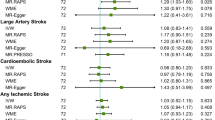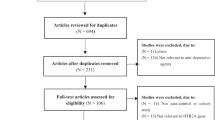Abstract
Polymorphisms in the 5-HTT and BDNF genes are shown to affect their function at the molecular and serum level. Prior work has tried to correlate the polymorphisms with post-stroke depression (PSD), the results nevertheless remain indefinitive. A plausible reason accounting for the uncertainty relates to the small sample of each published trial. In this study, we have performed a comprehensive meta-analysis in order to evaluate the effects of 5-HTT and BDNF polymorphisms (5-HTTLPR, STin2 VNTR, 5-HTR2a 102 T/C, Val66Met) on genetic risk of PSD. Human case-control trials were identified by computer-assisted and manual searches. The article search was performed until October 2014. Odds ratios (ORs) and 95 % confidence intervals (CIs) were calculated using the fixed effects meta-analysis to measure the effects 5-HTT and BDNF polymorphisms exerted on PSD. We also performed test of heterogeneity, test of publication bias, and sensitivity analysis to examine the reliability and stability of combined effects. 5-HTTLPR was clearly associated with genetic risk of PSD. The association seemed to be more pronounced in the homozygous model (OR = 0.34, 95 % CI = 0.23–0.51, P Q-test = 0.63). Both the heterozygous model and the recessive model showed 50 % decreased risk of PSD (OR = 0.50, 95 % CI = 0.37–0.67, P Q-test = 0.91; OR = 0.50, 95 % CI = 0.36–0.70, P Q-test = 0.43, respectively). Such significant association was also detected for Caucasian and Asian. These results were reliable and stable based on related analyses. Taken together, 5-HTTLPR polymorphism of the 5-HTT gene seems to protect against the occurrence of PSD. Small sample size for the polymorphisms within 5-HTT and BDNF genes may have caused underestimated associations, and a larger study is required to further assess the relations.



Similar content being viewed by others
References
Hackett ML, Yapa C, Parag V, Anderson CS (2005) Frequency of depression after stroke: a systematic review of observational studies. Stroke J Cereb Circ 36(6):1330–1340. doi:10.1161/01.STR.0000165928.19135.35
Kijowski S (2014) Difficulties in post-stroke gait improvement caused by post-stroke depression. Chin Med J 127(11):2085–2090
Spalletta G, Bossu P, Ciaramella A, Bria P, Caltagirone C, Robinson RG (2006) The etiology of poststroke depression: a review of the literature and a new hypothesis involving inflammatory cytokines. Mol Psychiatry 11(11):984–991. doi:10.1038/sj.mp.4001879
Torres GE, Gainetdinov RR, Caron MG (2003) Plasma membrane monoamine transporters: structure, regulation and function. Nat Rev Neurosci 4(1):13–25. doi:10.1038/nrn1008
Morris P, Hopwood M, Maguire K, Norman T, Schweitzer I (2003) Blunted prolactin response to d-fenfluramine in post-stroke major depression. J Affect Disord 76(1–3):273–278
Ramasubbu R, Tobias R, Buchan AM, Bech-Hansen NT (2006) Serotonin transporter gene promoter region polymorphism associated with poststroke major depression. J Neuropsychiatry Clin Neurosci 18(1):96–99. doi:10.1176/appi.neuropsych.18.1.96
Kohen R, Cain KC, Mitchell PH, Becker K, Buzaitis A, Millard SP, Navaja GP, Teri L, Tirschwell D, Veith R (2008) Association of serotonin transporter gene polymorphisms with poststroke depression. Arch Gen Psychiatry 65(11):1296–1302. doi:10.1001/archpsyc.65.11.1296
Egan MF, Kojima M, Callicott JH, Goldberg TE, Kolachana BS, Bertolino A, Zaitsev E, Gold B, Goldman D, Dean M, Lu B, Weinberger DR (2003) The BDNF val66met polymorphism affects activity-dependent secretion of BDNF and human memory and hippocampal function. Cell 112(2):257–269
Kim JM, Stewart R, Kim SW, Yang SJ, Shin IS, Kim YH, Yoon JS (2007) Interactions between life stressors and susceptibility genes (5-HTTLPR and BDNF) on depression in Korean elders. Biol Psychiatry 62(5):423–428. doi:10.1016/j.biopsych.2006.11.020
Gatt JM, Nemeroff CB, Dobson-Stone C, Paul RH, Bryant RA, Schofield PR, Gordon E, Kemp AH, Williams LM (2009) Interactions between BDNF Val66Met polymorphism and early life stress predict brain and arousal pathways to syndromal depression and anxiety. Mol Psychiatry 14(7):681–695. doi:10.1038/mp.2008.143
Fang J, Yan W, Jiang GX, Li W, Cheng Q (2011) Serotonin transporter gene polymorphism in Chinese patients with poststroke depression: a case-control study. Stroke J Cereb Circ 42(5):1461–1463. doi:10.1161/STROKEAHA.110.598672
Huang ZH (2008) Relationship between gene polymorphism concerned 5-HT transporter and post- stroke depression, dissertation. Kunming medical college
Kim JM, Stewart R, Bae KY, Kim SW, Kang HJ, Shin IS, Kim JT, Park MS, Kim MK, Park SW, Kim YH, Kim JK, Cho KH, Yoon JS (2012) Serotonergic and BDNF genes and risk of depression after stroke. J Affect Disord 136(3):833–840. doi:10.1016/j.jad.2011.09.029
Moher D, Liberati A, Tetzlaff J, Altman DG, Group P (2009) Preferred reporting items for systematic reviews and meta-analyses: the PRISMA statement. Ann intern Med 151 (4):264-269, W264
Diana BP (1999) Meta-analysis, decision analysis, and cost-effectiveness analysis. Oxford University Press, New York
Higgins JP, Thompson SG, Deeks JJ, Altman DG (2003) Measuring inconsistency in meta-analyses. BMJ 327(7414):557–560. doi:10.1136/bmj.327.7414.557
Egger M, Davey Smith G, Schneider M, Minder C (1997) Bias in meta-analysis detected by a simple, graphical test. BMJ 315(7109):629–634
Cao JX, Geng DQ, Jiang JD, Liu L, Jiang YL, Sun DJ (2011) Association between polymorphisms of 5-HT transporter gene and post-stroke depression. Chin J Pract Nerv Dis 14:17–19
Tang XH, Zeng KM (2012) Correlation of serotonin transporter gene polymorphism with post-stroke depression. Int J Pathol Clin Med 32:277–280
Ramasubbu R, Tobias R, Bech-Hansen NT (2008) Extended evaluation of serotonin transporter gene functional polymorphisms in subjects with post-stroke depression. Can J Psychiatry 53(3):197–201
Chen C (2011) Association study on polymorphsim of 5-HT2A T102C gene and post-stroke depression, dissertation. Southern Medical University
Lu LP, Zhu YB, Cheng JY (2013) The correlation between Val66Met polymorphism in brain-derived neurotrophic factor and post-stroke depression. Chin J Clin Neurosci 21:413–417
Kim JM, Stewart R, Kim SW, Shin IS, Yang SJ, Yoon JS (2011) Cholesterol and serotonin transporter polymorphism interactions in late-life depression. Neurobiol Aging 32(2):336–343. doi:10.1016/j.neurobiolaging.2009.02.017
Lesch KP, Bengel D, Heils A, Sabol SZ, Greenberg BD, Petri S, Benjamin J, Muller CR, Hamer DH, Murphy DL (1996) Association of anxiety-related traits with a polymorphism in the serotonin transporter gene regulatory region. Science 274(5292):1527–1531
Sakakibara Y, Kasahara Y, Hall FS, Lesch KP, Murphy DL, Uhl GR, Sora I (2014) Developmental alterations in anxiety and cognitive behavior in serotonin transporter mutant mice. Psychopharmacology. doi:10.1007/s00213-014-3554-x
Gryglewski G, Lanzenberger R, Kranz GS, Cumming P (2014) Meta-analysis of molecular imaging of serotonin transporters in major depression. J Cereb Blood Flow Metab Off J Int Soc Cereb Blood Flow Metab 34(7):1096–1103. doi:10.1038/jcbfm.2014.82
Funding
This research was funded by Baoding Research and Development Mentoring Program of Science and Technology of China (contract grant number: 10ZF014), Baoding Research and Development Mentoring Program of Science and Technology of China (contract grant number: 08ZF007), and Hebei Provincial Natural Science Foundation of China grant (contract grant number: H2013201283). The funders had no role in study design, data collection and analysis, decision to publish, or preparation of the manuscript.
Author information
Authors and Affiliations
Corresponding author
Rights and permissions
About this article
Cite this article
Zhao, Q., Guo, Y., Yang, D. et al. Serotonin Transporter Gene 5-HTTLPR Polymorphism as a Protective Factor Against the Progression of Post-Stroke Depression. Mol Neurobiol 53, 1699–1705 (2016). https://doi.org/10.1007/s12035-015-9120-7
Received:
Accepted:
Published:
Issue Date:
DOI: https://doi.org/10.1007/s12035-015-9120-7




